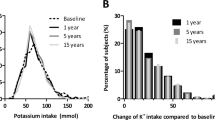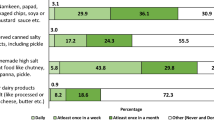Abstract
Background/objectives:
To investigate the dietary sources of sodium and potassium and to explore the biological, behavioural and socio-demographic factors associated with a high sodium and low potassium diet in a general population.
Subjects/methods:
Cross-sectional dietary survey carried out in 1998 and 1999 in nationally representative samples of adults (n=1474) and children (n=1018). Daily sodium and potassium intakes were estimated using a 7-day food record after exclusion of underreporters.
Results:
Mean sodium intake was well above, whereas mean potassium intake was largely below the current recommendations in adults and children. The consumption of a high sodium and low potassium diet appeared very early in life and increased up to adulthood, especially in men living in small communities. Despite the fact that sodium and potassium intakes were positively correlated to each other and to total food intake, several food categories showed a sodium/potassium intake ratio well above one (cheeses, cooked pork meats, breads, breakfast cereals, soups, fast foods, pastries and sugary products) whereas others presented a ratio well below one (fruits, vegetables, dairy products, meats and hot beverages).
Conclusions:
High sodium and low potassium intakes were widespread in the population. The fact that the main dietary sources of sodium and potassium were, for the most part, not the same demonstrates the feasibility of simultaneously increasing sodium intake and decreasing potassium intake at the individual level.
This is a preview of subscription content, access via your institution
Access options
Subscribe to this journal
Receive 12 print issues and online access
$259.00 per year
only $21.58 per issue
Buy this article
- Purchase on Springer Link
- Instant access to full article PDF
Prices may be subject to local taxes which are calculated during checkout

Similar content being viewed by others
References
Allison ME, Walker V (1986). The sodium and potassium intake of 3 to 5 year olds. Arch Dis Child 61, 159–163.
Arbeit ML, Nicklas TA, Berenson GS (1992). Considerations of dietary sodium/potassium/energy ratios of selected foods. J Am Coll Nutr 11, 210–222.
Bates CJ, Cole TJ, Mansoor MA, Pentieva KD, Finch S (2001). Geographical variations in nutrition-related vascular risk factors in the UK: National Diet and Nutrition Survey of People Aged 65 Years and Over. J Nutr Health Aging 5, 220–225.
Beer-Borst S, Coastanza MC, Pechere-Bertschi A, Morabia A (2009). Twelve-year trends and correlates of dietary salt intakes for the general adult population of Geneva, Switzerland. Eur J Clin Nutr 63, 155–164.
Brion MJ, Ness AR, Davey Smith G, Emmett P, Rogers I, Whincup P et al. (2008). Sodium intake in infancy and blood pressure at 7 years: findings from the Avon Longitudinal Study of Parents and Children. Eur J Clin Nutr 62, 1162–1169.
Caggiula AW, Wing RR, Nowalk MP, Milas NC, Lee S, Langford H (1985). The measurement of sodium and potassium intake. Am J Clin Nutr 42, 391–398.
Chen Q, Marques-Vidal P (2007). Trends in food availability in Portugal in 1966–2003: comparison with other Mediterranean countries. Eur J Nutr 46, 418–427.
Clark AJ, Mossholder S (1986). Sodium and potassium intake measurements: dietary methodology problems. Am J Clin Nutr 43, 470–476.
Cohen HW, Hailpern SM, Fang J, Alderman MH (2006). Sodium intake and mortality in the NHANES II follow-up study. Am J Med 119, 275.e7–275.e14.
Deville JC (1991). A theory of quota surveys. Survey Methodol 17, 163–181.
Ervin RB, Wang CY, Wright JD, Kennedy-Stephenson J (2004). Dietary intake of selected minerals for the United States population: 1999–2000. Adv Data 341, 1–5.
Favier JC, Ireland J, Toque C, Feinberg M (1995). Répertoire général des aliments. Tables de composition. CIQUAL-REGAL, 2nd edn.
Ganguli MC, Grimm RHJ, Svendsen KH, Flack JM, Grandits GA, Elmer PJ (1997). Higher education and income are related to a better Na:K ratio in blacks: baseline results of the Treatment of Mild Hypertension Study (TOMHS) data. Am J Hypertens 10, 979–984.
Gerber AM, James SA, Ammerman AS, Keenan NL, Garrett JM, Strogatz DS et al. (1991). Socioeconomic status and electrolyte intake in black adults: the Pitt County Study. Am J Public Health 81, 1608–1612.
Goldberg GR, Black AE, Jebb SA, Cole TJ, Murgatroyd PR, Coward WA et al. (1991). Critical evaluation of energy intake data using fundamental principles of energy physiology: 1. Derivation of cutoff limits to identify under-recording. Eur J Clin Nutr 45, 569–581.
Hajjar I, Kotchen T (2003). Regional variations of blood pressure in the United States are associated with regional variations in dietary intakes: the NHANES-III data. J Nutr 133, 211–214.
He FJ, MacGregor GA (2001). Fortnightly review: beneficial effects of potassium. BMJ 323, 497–501.
He FJ, Marrero NM, Macgregor GA (2008). Salt and blood pressure in children and adolescents. J Hum Hypertens 22, 4–11.
Heird WC, Ziegler P, Reidy K, Briefel R (2006). Current electrolyte intakes of infants and toddlers. J Am Diet Assoc 106, S43–S51.
Institute of Medicine (2004). Dietary reference intakes for water, potassium, sodium, chloride and sulfate. The National Academies Press. http://books.nap.edu/catalog.php?record_id=10925.
Intersalt Cooperative Research Group (1988). Intersalt: an international study of electrolyte excretion and blood pressure. Results for 24 h urinary sodium and potassium excretion. Intersalt Cooperative Research Group. BMJ 297, 319–328.
Kesteloot H, Elliott P, Lesaffre E (1990). On the sex ratio of urinary cation excretion obtained from Intersalt and other epidemiological studies. J Hum Hypertens 4, 603–607.
Kesteloot H, Joossens JV (1990). The relationship between dietary intake and urinary excretion of sodium, potassium, calcium and magnesium: Belgian Interuniversity Research on Nutrition and Health. J Hum Hypertens 4, 527–533.
Kodama N, Morikuni E, Matsuzaki N, Yoshioka YH, Takeyama H, Yamada H et al. (2005). Sodium and potassium balances in Japanese young adults. J Nutr Sci Vitaminol (Tokyo) 51, 161–168.
Le Moullec N, Deheeger M, Preziosi P, Montero P, Valeix P, Rolland-Cachera MF et al. (1996). Validation du manuel-photos utilisé pour l’enquête alimentaire de l’étude SU.VI.MAX. Cah Nutr Diet 31, 158–164.
Leclercq C, Ferro-Luzzi A (1991). Total and domestic consumption of salt and their determinants in three regions of Italy. Eur J Clin Nutr 45, 151–159.
Maldonado-Martin A, Garcia-Matarin L, Gil-Extremera B, Avivar-Oyonarte C, Garcia-Granados ME, Gil-Garcia F et al. (2002). Blood pressure and urinary excretion of electrolytes in Spanish schoolchildren. J Hum Hypertens 16, 473–478.
Mancia G, De Backer G, Dominiczak A, Cifkova R, Fagard R, Germano G et al. (2007). 2007 Guidelines for the Management of Arterial Hypertension: The Task Force for the Management of Arterial Hypertension of the European Society of Hypertension (ESH) and of the European Society of Cardiology (ESC). J Hypertens 25, 1105–1187.
McKeown NM, Day NE, Welch AA, Runswick SA, Luben RN, Mulligan AA et al. (2001). Use of biological markers to validate self-reported dietary intake in a random sample of the European Prospective Investigation into Cancer United Kingdom Norfolk cohort. Am J Clin Nutr 74, 188–196.
Meneton P, Galan P, Bertrais S, Heudes D, Hercberg S, Menard J (2008). High plasma aldosterone and low renin predict blood pressure increase and hypertension in middle-aged Caucasian populations. J Hum Hypertens 22, 550–558.
Meneton P, Jeunemaitre X, de Wardener HE, MacGregor GA (2005). Links between dietary salt intake, renal salt handling, blood pressure, and cardiovascular diseases. Physiol Rev 85, 679–715.
National High Blood Pressure Education Program (2003). The Seventh Report of the Joint National Committee on the Prevention, Detection, Evaluation, and Treatment of High Blood Pressure. http://www.nhlbi.nih.gov/guidelines/hypertension/express.pdf.
Pietinen P (1982). Estimating sodium intake from food consumption data. Ann Nutr Metab 26, 90–99.
Reinivuo H, Valsta LM, Laatikainen T, Tuomilehto J, Pietinen P (2006). Sodium in the Finnish diet: II trends in dietary sodium intake and comparison between intake and 24-h excretion of sodium. Eur J Clin Nutr 60, 1160–1167.
Schachter J, Harper PH, Radin ME, Caggiula AW, McDonald RH, Diven WF (1980). Comparison of sodium and potassium intake with excretion. Hypertension 2, 695–699.
Scientific Advisory Committee on Nutrition (2003). Salt and Health. http://www.food.gov.uk/multimedia/pdfs/saltandhealth0503.pdf.
Takemori K, Mikami S, Nihira S, Sasaki N (1989). Relationship of blood pressure to sodium and potassium excretion in Japanese women. Tohoku J Exp Med 158, 269–281.
Uusi-Rasi K, Fogelholm M, Nenonen A, Pasanen M (1999). The accuracy of estimating calcium, sodium and potassium intake with a food record. Scand J Nutr 43, 66–69.
Van Cauwenbergh R, Hendrix P, Robberecht HJ, Deelstra HA (1999). Daily dietary sodium and potassium intake in Belgium, using duplicate portion sampling. Eur Food Res Technol 209, 63–67.
Volatier JL (2000). Enquête Individuelle et Nationale sur les Consommations Alimentaires. Editions TEC & DOC: Paris.
Witschi JC, Capper AL, Hosmer DWJ, Ellison RC (1987). Sources of sodium, potassium, and energy in the diets of adolescents. J Am Diet Assoc 87, 1651–1655.
World Health Organization (2003). Diet, nutrition and the prevention of chronic diseases. http://whqlibdoc.who.int/trs/WHO_TRS_916.pdf.
World Health Organization (2007). Reducing salt intake in populations. http://www.who.int/dietphysicalactivity/reducingsaltintake_EN.pdf.
Acknowledgements
Joël Ménard received funding from the Association Robert Debré pour la Recherche Médicale and Pierre Meneton from the Institut National pour la Santé et la Recherche Médicale.
Author information
Authors and Affiliations
Corresponding author
Additional information
Guarantors: P Meneton and JL Volatier.
Contributors: PM performed and interpreted statistical analyses and drafted the article; LL, AT, AD and JLV supervised the survey and data collection, JI compiled sodium and potassium food composition table; JM contributed to the writing of the final article.
Rights and permissions
About this article
Cite this article
Meneton, P., Lafay, L., Tard, A. et al. Dietary sources and correlates of sodium and potassium intakes in the French general population. Eur J Clin Nutr 63, 1169–1175 (2009). https://doi.org/10.1038/ejcn.2009.57
Received:
Revised:
Accepted:
Published:
Issue Date:
DOI: https://doi.org/10.1038/ejcn.2009.57
Keywords
This article is cited by
-
Salt intake and blood pressure in Iranian children and adolescents: a population-based study
BMC Cardiovascular Disorders (2021)
-
Elevated urinary Na/K ratio among Lebanese elementary school children is attributable to low K intake
European Journal of Nutrition (2017)
-
A 6-month randomised controlled trial investigating effects of Mediterranean-style diet and fish oil supplementation on dietary behaviour change, mental and cardiometabolic health and health-related quality of life in adults with depression (HELFIMED): study protocol
BMC Nutrition (2016)
-
Salt intake and eating habits of school-aged children
Hypertension Research (2016)
-
Potassium urinary excretion and dietary intake: a cross-sectional analysis in 8–10 year-old children
BMC Pediatrics (2015)



